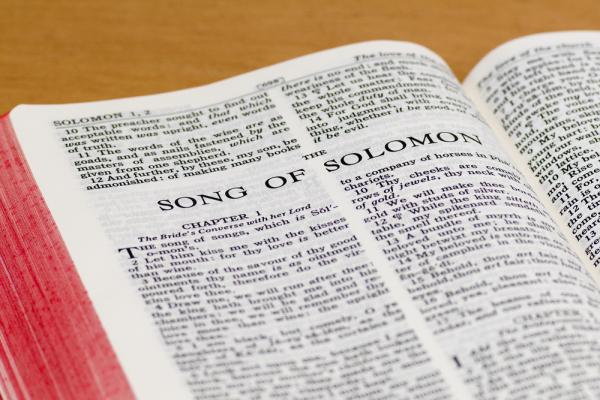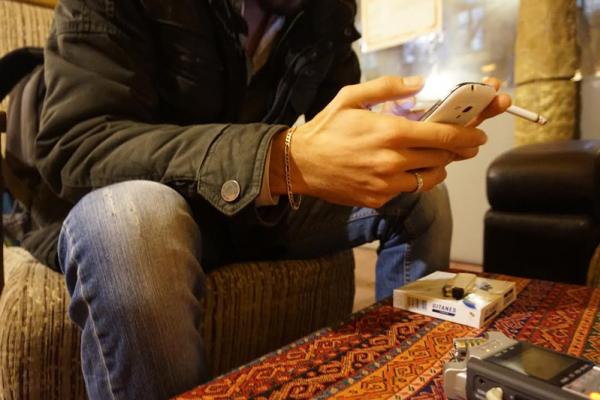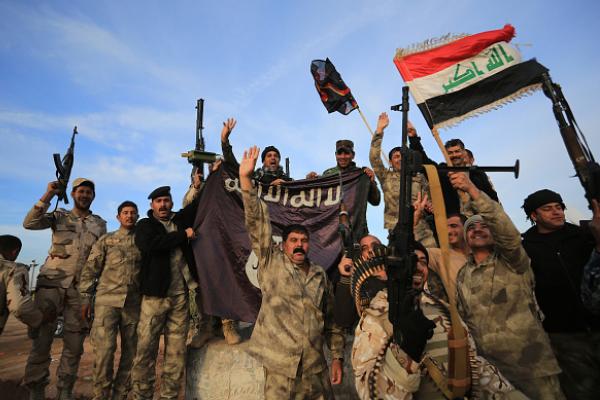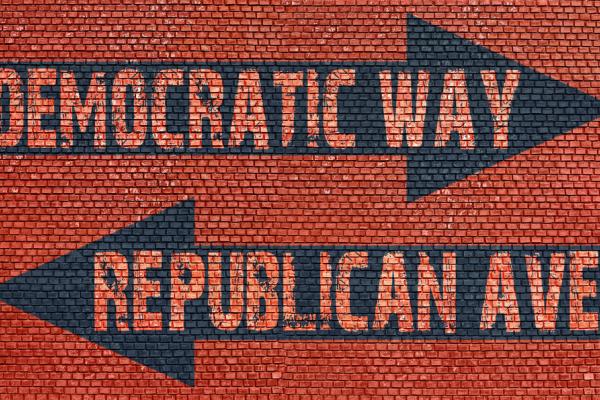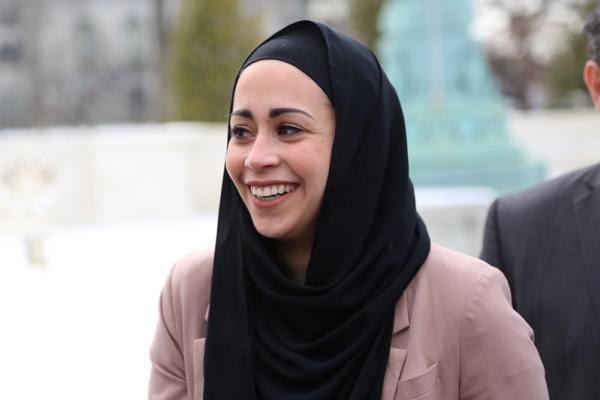1. PHOTOS: Painter Immortalized Last Meals of 600 Prisoners Put to Death
Artist Julie Green collects information published in death-row inmates’ death notices about their last moments. She then puts cobalt blue paint to porcelain plates to illustrate their final meals — from pizza and birthday cake to Jolly Ranchers. Her goal: “to continue paining fifty plates a year until capital punishment is abolished.”
2. Net Neutrality Victory Is Civil Rights History in the Making
“Today’s civil rights activists have a much more powerful tool at our disposal – the open Internet. Our ability to be heard, counted, and visible in this democracy now depends on an open Internet, because it allows voices and ideas to spread based on their quality – not the amount of money behind them.”
3. WATCH: It Turns Out Lighting Affects Color
And lots of other things, actually. If you’re still hashing it out with your roommates or spouse about the color of #TheDress, here’s science (and music!) to the rescue. (Team #whiteandgold!) Also, if you need more science, you can always ask Science Mike, who offers this great video explainer.
4. Activists Warn of End of Christian Presence in Middle East
Following ISIS’ kidnapping of at least 90 Assyrian Christians in an attack on about 35 mostly Assyrian settlements, groups in the region warn that we may be witnessing the end of Christian presence in the region: “After the Iraq war of 2003, and since the Syrian crisis began, the persecution unleashed on them – including extortion, kidnappings, murder, the ethnic cleansing of entire swaths of Baghdad, the Nineveh plains, and now much of north-east Syria, has been so vast that their very existence in their ancestral homelands is in grave peril.”
5. In 23 States, the Largest Religious Group Is Now ‘Unaffiliated’
This, according to Public Religion Research Institute’s just-released American Values Atlas, which breaks down various religious and political demographics. Find out the largest religious group in your state at the link!
6. WATCH: Jim Inhofe’s Snowball Has Disproven Climate Change Once and For All
That one time a United States senator — the one who also happens to be the chairman of the environment committee — threw a snowball while on the floor to dispute climate change. Because snow.
7. An Anti-ISIS Summit in Mecca
“Whether ISIS’s deeds are labeled ‘violent extremism’ or ‘Islamized terrorism,’ the conversations in Washington and Mecca had at least one thing in common: They deepened the debate over whether ISIS and its fellow travelers are ‘Islamic,’ and whether the answer matters in the first place. That debate is not just academic. It has real consequences for how the Islamic State’s opponents mount their counteroffensive.”
8. VIDEO: Banksy Goes Undercover in Gaza, Releases MIni-Documentary
The unidentified street artist Banksy has re-emerged in Gaza to create a political mini-documentary about life inside the war-torn region.
9. Why We Must Change How We Change the World
World Relief President and CEO Stephan Bauman’s new book Possible: A Blueprint for Changing How We Change the World is now out. In this piece, he lays out why he is hopeful about the future of efforts to address injustice: “We are caught in a vicious cycle, a dangerous dynamic that shapes our views about the people who experience suffering. As a result, those trapped in poverty are dehumanized and poverty is dumbed down while good, well-intended people really believe they are caring, world-conscious, and ethical. But change is coming.”
10. 10 Things Catholics Are Tired of Hearing
Why do you worship statues? Why do you pray to Mary instead of God? And more confusion in the Protestant understanding of Catholicism. Handy to bookmark for the next inevitable conversation about the purpose of confession or the Apocrypha.
Why are we so fascinated with any historical artifact — relics, as some call them — associated with Jesus?
Even the most suspect claim of a “lost” gospel or an “explosive” archaeological find that purports to shed light on the man from Galilee can generate a media frenzy, and gives believers — or skeptics — fresh evidence to try to finally win their argument while leaving their foes on the defensive.
Think of the recent “gospel” that seemed to show Jesus had a wife — and she was, of all people, the scandalous Mary Magdalene. Or the discovery a few years ago of an ancient papyrus that depicted Judas as the hero of the gospel story, not the great betrayer. Or, a few years before that, the revelation of a bone box with “brother of Jesus” inscribed on the top.
The argument in these purported blockbuster discoveries is that everything we’ve ever known about Christianity is probably false and that there has been a massive, millennia-long cover-up to hide the real truth. Remember The Da Vinci Code? There’s a reason that fiction sounded like fact to a lot of people.
Yet in spite of the overblown claims and dodgy artifacts floating around out there, genuine artifacts and solid historical research still provide the best window into that long-ago world and the best chance to figure out who Jesus really was, and what he meant.
A student group in South Africa this month called on all Jews to leave the Durban University of Technology, an act of anti-Semitism that Americans could not imagine on their own college campuses.
But a comprehensive survey of anti-Semitism at American colleges released this week shows that significant hostility is directed at Jews on U.S. campuses, too.
The National Demographic Survey of American Jewish College Students, produced by a Trinity College team well-known for its research on religious groups, found that 54 percent of Jewish students experienced anti-Semitism on campus in the first six months of the 2013-2014 academic year.
Professors Barry A. Kosmin and Ariela Keysar asked 1,157 students in an online questionnaire about the types, context and location of anti-Semitism they had encountered, and found that anti-Jewish bias is a problem for Jews of all levels of religious observance.
“And this is a national problem; it’s not just happening in pockets of areas,” Keysar said. “Hopefully people will read this survey as a wake-up call. Clearly, the students want us to do something.”
The survey, she also noted, was given to students months before last summer’s war between Israel and Gaza, which ignited much anti-Israel sentiment on college campuses, sentiment that at times crossed the line into anti-Semitism.
I am black, but [AND] comely, O ye daughters of Jerusalem, as the tents of Kedar, as the curtains of Solomon. Look not upon me, because I am black, because the sun hath looked upon me: my mother's children were angry with me; they made me the keeper of the vineyards; but mine own vineyard have I not kept. Song of Songs 1: 5-6
As the Executive Director for Faith in New York, an affiliate of the PICO National Network, I organize faith communities to take action for justice concerning issues that threaten the health of our communities. One of our campaigns is Live Free New York, which is a part of a national movement in which people of faith are working to end mass incarceration, gun violence, and police brutality through policy change and direct action.
Mass incarceration is an issue with many tentacles, and in New York, one tentacle is school suspension rates that are through the roof for black children. What many in the black community don’t understand is that according to data from the Office for Civil Rights at the U.S. Department of Education, as presented in a recent New York Times article: “black girls in public elementary and secondary schools nationwide are suspended at a rate of 12 percent compared with a rate of just 2 percent for white girls and more than girls of any race or ethnicity. … An analysis by Villanova [University] researchers of data from the National Longitudinal Surveys of Youth and the National Longitudinal Study of Adolescent Health indicated that black girls with the darkest skin tones were three times more likely to be suspended than black girls with the lightest skin.”
Hassan, a chain-smoking 20-year-old from Syria, sits in a cafe across the border from his homeland, one of thousands who escaped the clutches of the Islamic State group.
Not so long ago, he was one of their recruits, having undergone four months of religion training where he learned how to pray and read the Quran, while at the same time patrolling the rebel stronghold’s checkpoints.
“We loved them so much,” said Hassan, who was not willing to be identified by his real name for fear of retribution against family members still in Syria. “They gave us so much information and taught us very sweet things about Islam.”
But then things started to change.
As the Islamic State group grew in power, he saw more orders to target members of other widely popular Sunni rebel groups. At checkpoints, Hassan said, recruits were commanded to arrest or kill any members affiliated with the Free Syrian Army, an umbrella of rebel groups that he and his family supported.
His mother, who was growing increasingly disgruntled with the Islamic State’s strict rules, confronted him. “‘Why are you doing this?'” he said she told him. ‘”This is wrong.'”
It wasn’t long after, as intense fighting broke out with another Islamist brigade, Ahrar ash-Sham, that Hassan decided to stop fighting for the Islamic State.
It was 1987. I walked across Rutgers University campus with another freshman friend. We were on our way to a meeting for Campus Crusade for Christ (now Cru). In the gobs of our gab we happened upon the topic of the recent scandalous departure of Intervarsity Christian Fellowship president, Gordon McDonald. Interim President, Tom Dunkerton, guided the organization for the next year, appointing Dr. Samuel Barkat as first VP of Multiethnic Ministries. Soon after, Dr. Steve Hayner would accept the mantle of president of the troubled organization. Over the next 13 years, Hayner guided Intervarsity into a period of stability, growth, and racial healing.
Perhaps the most significant contribution of Hayner’s leadership was his close partnership with Dr. Barkat. Together they stood on the sovereign foundations of Intervarsity’s historic struggles toward racial righteousness and guided the organization through a deep examination of its multiethnic dynamics and its white dominant culture. Ultimately, their work led the parachurch collegiate ministry through a transformative examination of its own white western cultural lens and how that lens shaped their understanding of Jesus and the gospel.
As an evangelical theologian and pastor, I want to say that ISIS is evil. Evil is a term we don’t normally hear in the media or politics, which is likely a good thing given our lack of public morality and civility these days. Indeed, judgementalism was condemned by Jesus, but is still often practiced by many churches — so humility is always called for. But it is still a responsibility of the faith community to name evil where it clearly exists in the world. And by any standards, the actions of ISIS are evil.
The latest report issued by the Office of the UN High Commissioner for Human Rights and the UN Assistance Mission for Iraq on “The Protection of Civilians in Armed Conflict in Iraq,” catalogues the human rights atrocities committed by ISIS, making it abundantly clear that this group is evil. They include:
- attacks directly targeting civilians and civilian infrastructure,
- executions and other targeted killings of civilians,
- abductions, rape and other forms of sexual and gender based violence perpetrated against women and children,
- slavery and trafficking of women and children,
- forced recruitment of children,
- destruction or desecration of places of religious or cultural significance,
- wanton destruction and looting of property, and denial of fundamental freedoms.
The report goes on to identify the targeting of ethnic and religious groups — such as Christians, Yazidis, Shi’ite Muslims, and many others —and subjecting them to “gross human rights abuses, in what appears as a deliberate policy aimed at destroying, suppressing or expelling these communities permanently from areas under their control.” The report describes the actions as possible “war crimes, crimes against humanity, and possibly genocide.”
In light of these sober findings, the faith community must remind the world that evil can be overcome, and that individuals involved in evil systems and practices can be redeemed. But how to overcome evil is a very complicated theological question, which requires much self-reflection. In trying to figure out how to overcome evil, it is often helpful to first decide how not to. Here is a good example of how not to respond to the reality of evil.
The phenomenon of “creeping normality” allows for significant changes to be deemed acceptable when they occur gradually over time, in relatively unnoticed increments, rather than single steps or dramatic and noticeable instances. The “boiling frog” metaphor, which illustrates the familiar account of an unassuming amphibian that is slowly and successfully cooked to death, reveals not only how such instances can occur, but also how a calculated and protracted alteration (produced by those with power to turn up the heat) can possess disastrous results if not noticed and properly countered (by those left in the water). We need not look far for modern-day examples.
Extreme partisanship has crept into our political normality. As revealed last year by the Pew Research Center, our civic temperature is methodically rising, perhaps beyond the boiling point. The study states:
“The overall share of Americans who express consistently conservative or consistently liberal opinions has doubled over the past two decades from 10% to 21%. [As a result], the center has gotten smaller: 39% of Americans currently take a roughly equal number of liberal and conservative positions, down from 49% in surveys conducted in 1994 and 2004.”
Like Jim Wallis, I believe that budgets are moral documents. They reflect our deepest values. Like budget decisions, climate decisions are moral decisions — decisions that affect the environment reveal our moral commitments.
How does Barack Obama measure up on the ‘moral leadership for the environment’ scorecard?
President Obama vetoed the Keystone XL pipeline on Tuesday. He also forged a historic agreement with Chinese Presidenta Xi Jinping in November to reduce carbon emissions in the U. S. by 26-28 percent from 2005 levels by 2025. He has worked with the auto industry to put historic fuel economy standards into place. When he wasn’t able to convince Congress to pass environmental legislation, he worked behind the scenes — using the Clean Air Act of 1970 to set tougher environmental standards. All of these actions give him points for moral leadership.
At the same time, some criticized Obama earlier in his presidency for not doing enough. In 2011, Al Gore published an article in Rolling Stone magazine saying Obama had “thus far failed to use the bully pulpit to make the case for bold action on climate change.” During the first two years of his administration, many environmental activists expected more legislation to slow climate change. Cole Stangler argues that, even given legislative obstacles, Obama could have done more through federal agencies.
Samantha Elauf was a teenager who loved clothes and applied to work in an Abercrombie & Fitch Kids store in her native Tulsa, Okla., in 2008. But Elauf, a Muslim, also happens to wear a headscarf. So she didn’t get the job.
No one — not even Abercrombie & Fitch — disputes that her hijab cost her the job offer. And the law, Title VII of the Civil Rights Act of 1964, states that an employer can’t deny employment based on an worker’s religious practice, unless accommodating it would prove terribly burdensome.
At the time, Abercrombie had a “no hats” policy for its sales associates. When the U.S. Supreme Court heard Elauf’s case on Feb. 25, Justice Ruth Bader Ginsburg summed up the religious exemption required of the company: “Title VII doesn’t require accommodating baseball caps, but it does require accommodating religious practice.”
So why did this case make it all the way to the Supreme Court?
Elauf, though she won in a federal district court in 2011, lost in a federal appeals court in 2013. At the 10th U.S. Circuit Court of Appeals in Denver, the company’s argument — that it shouldn’t have had to give a religious accommodation because Elauf never asked for one — found traction.
Do we really want companies delving into an applicant’s religious practice in order to determine whether the person might want an accommodation, Abercrombie lawyer Shay Dvoretzky asked the justices on Wednesday.
“This will inevitably lead employers to stereotype,” he said.


